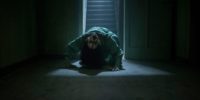From Mystics to Manufacturing
Talking to the spirits, bridging the abyss between this world and the next, for guidance or fortune or forbidden knowledge, has been attempted by humans for as long as there has been a record or our ramblings in the dark. Shamans in the Paleolithic era, oracles in ancient Greece, priests in ancient Egypt, and more or less every representative of organized and unorganized religions and mysticism have tried to convey messages from the other side to the hopeful masses.
In the 19th century, the scientific and commercialized terrain of America gave birth to its own particular form of dead-speak, known as Spiritualism. It began with three sisters living in Hydesville, New York, an area now part of the town of Arcadia, coincidentally a name that has echoes in the lore of Witchcraft and Greek mythology. The Fox sisters claimed to be in contact with a local murder victim and that they communicated through a series of rapping noises. It’s irrelevant for this article that years later the Fox sisters admitted it was all a hoax, or that the Spiritualist practice/religion continued to grow despite numerous revelations and investigations into hucksters, frauds, and cons.
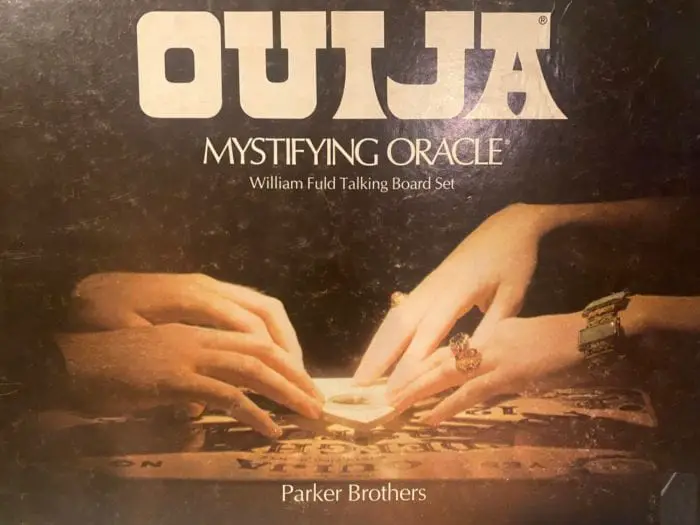
What is important is that the actual practice of Spiritualism, the elaborately staged productions in which mediums would attempt to decipher the staccato communications of deceased loved ones or historical figures, were in the end…tedious. As noted by Linda Rodriguez McRobbie in her excellent article for Smithsonian Magazine:
As spiritualism had grown in American culture, so too did frustration with how long it took to get any meaningful message out of the spirits, says Brandon Hodge, Spiritualism historian. Calling out the alphabet and waiting for a knock at the right letter, for example, was deeply boring. After all, rapid communication with breathing humans at far distances was a possibility—the telegraph had been around for decades—why shouldn’t spirits be as easy to reach? People were desperate for methods of communication that would be quicker—and while several entrepreneurs realized that, it was the Kennard Novelty Company that really nailed it.
What did this group of lawyers and politicians, led by Charles Kennard and Elijah Bond, do to address this unserved demand in the marketplace? In the best Protestant and Capitalist traditions of America, they made contacting the deceased simpler, easier, and they took out the gatekeeper/middle person—the medium. Bond filed a patent in 1891 for a talking-board, and what he called a “table” and is now known as a planchette. Bond describes his invention in the government required paperwork:
My invention relates to improvements in toys or games, which I designate as an “Ouija or Egyptian luck-board;” and the objects of the invention are to produce a toy or game by which two or more persons can amuse themselves by asking questions of any kind and having them answered by the device used and operated by the touch of hand, so that the answers are designated by letters on the board.
Notably, he describes the board as a toy or game, not as a mystic or religious device, and though he specifies that the board will answer questions put to it, he is very careful to specify how, likely due to the fact that he had no belief in its supernatural properties and believed, like his partners, that any answers received were simply a psychological response and action. This was a purely capitalist venture and the boards were being made because these men recognized there was profit to be had. However, it did lead to one of the oddest governmental encounters on record. Apparently, in order to obtain a patent for an invention, the applicant has to demonstrate that the device actually works. This meant that Bond had to drag his sister-in-law medium to the Washington Patent Office, where it was demanded that she get the board to spell out the allegedly unknown name of the patent office, which it successfully did. As McRobbie noted, it apparently never occurred to anyone that Bond was an actual patent attorney who probably knew the name of the officer in advance.
The Ghost in Our Home
Sales for the Kennard talking board sky-rocketed. Americans were ready for easy access to Occultism from the comfort of their own home. In the best marketing tradition, it promised excitement and danger but controlled, packaged, and bought in the back of a catalog next to raincoats and the newest brand razor.
This article isn’t an in-depth history of the twisted path of witchboard production, it simply can’t be, that would need a book and that book would be one that I would definitely read. I’ve included some links at the bottom of this article to the most helpful and fascinating sites I found while researching. The authority seems to be a historian named Robert Murch, and his online histories, photographs, and documentation led me down many long and enjoyable rabbit-holes.
Beyond the initial founding of the Kennard company, the next important moments in the history of the Ouija would be the passing, in 1897, of all rights to a one-time board-varnisher at Kennard, William Fuld. The transfer was only for three years, but Fuld and his brother were so successful in their marketing of the board and related merchandise, like Ouija mailing envelopes, that he continued to sell them even after the rights lapsed, leading to a protracted legal battle that lasted until 1919.
Fuld was so good at selling that he became known as the father of the Ouija, even though he had no hand in the design or creation, or even in founding the Kennard company, popular memory simply ignored that pre-history. There were, of course, competitors and knock-offs. A multitude of companies tried to create and market their own versions, beginning with Kennard and his Volo board after he left his eponymous company. Alternate names and graphic designs abounded: The Crystal Gazer Board, The Mecca Answer Board, the glow-in-the-dark Yogee Board, The Wizard Tray (it’s an Ouija Board but in tray form!), Veda the Magic Answer man Board, The Swami Mystery Talking Board, the variations on eastern stereotypes and Voodoo stereotypes in the ’40s up through the ’60s goes on and on.
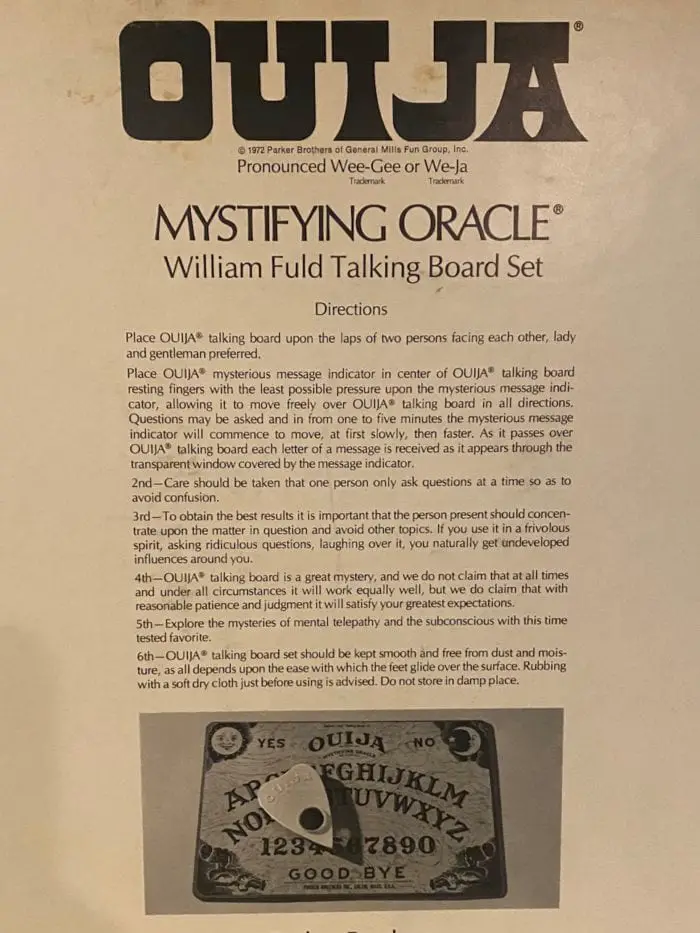
As far as collectors go, most of the effort to discover and possess pieces of talking-board history are focused on this era between Fuld and 1966. That’s when Fuld’s heirs (he had died an early death after falling backward out of a window, overseeing a flagpole) sold the rights to the Ouija name and design to Parker Brothers. Until 1972, they issued the William Fuld Ouija Mystifying Oracle board in the exact same packaging as Fuld had, with the Parker Brothers name inserted in the corner. By 1972, they began issuing them in the now-iconic packaging featuring shadowy hands on the planchette, replacing the prior illustration of a mysterious, shrouded oracle and removing the last vestige of mediated spiritualism from the device, speaking to the dead was now firmly in the consumer’s hands…if they dared. The first year after Parker Brothers took over, the Ouija outsold even Monopoly as the most bought game. Droves of families wandering down brightly lit, well-stocked aisles of inviting cardboard boxes holding hours of fun, and most chose the “game” that promised a least a hist of mystery and the unexpected. It was an experience closer to the free-ranging adventure of Dungeons and Dragons than the lock-step of Sorry or Battleship.
From Mysticism to Mcguffin
Horror movies can be tough to set up. Most of the time you have to get your protagonist into an unsafe place where the barrier between this world and the other can be portrayed as convincingly thin: an old, spooky house, a cabin in the woods, a graveyard, etc. The Internet, electronics, and phone cameras have changed a lot of that. It’s easier to bring the supernatural into the home through a million little portals/screens in every house. But before the cell-phone era, there was the Ouija era. If a screen-writer needed a plot device to shove the supernatural right into the modern home, there was a mystifying, spooky, prepackaged doorway to the beyond sitting on the top shelf of the average American home. A Google search can get you to the extensive list of movies going back to the black-and-white era that have featured the Ouija, but I wanted to focus on just three examples that really set the mood.
The Exorcist (1973)
It wasn’t the first, it isn’t the most plot-centric example, but it’s the movie that warned most people to the number one danger of the Ouija Board: You never, ever, ever use the Ouija alone! To do so is to invite a malevolent presence into your home. The Ouija Board is a party game and the spirits demand that it be treated as such. It also established the typical idyllic American home, in this case situated in Georgetown, a milieu of academia and science, surely there is no dark corner here that can allow for evil to slither out of a hidden cave in the Middle East and directly into Middle America (I know it’s the East Coast but that’s not as snappy). But there it is, in a dusty basement corner, not even a dark basement, more like a well-lit game and utility room, purchased at the local Woolworth’s aisle 11 next to the Parcheesi, a fun-time Pandora’s Box for the whole family. It’s worth noting that the movie came out in 1973, the year after Parker Brothers rebranded the Ouija packaging with it’s a more contemporary design.
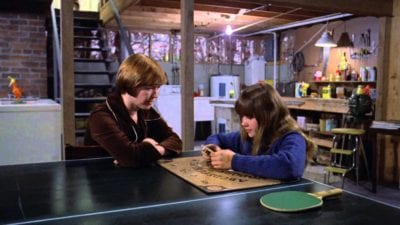
Witchboard (1986)
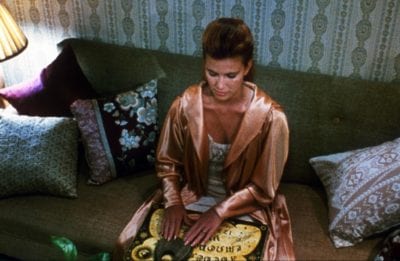
This is a slice of perfect ’80s cheese-pie. Kevin S. Tenney’s (Night of the Demons) first film, written while he was still in film school. It has everything: goofy sidekicks, in-camera special effects, loveable punk mediums, and ’80s icon Tawny Kitaen, fresh off of another ’80s favorite of mine, Bachelor Party. Tawny again begins the whole thing by daring to use a witchboard (NOT—the film’s legal counsel will tell you—copyright-protected Ouija Board brand) alone when it was left behind after a house party. This opens the spiritual door and allows the spirit of a dead killer to slowly torture her and take over her body. Besides personal affection, the movie is a good example of the ever-present and confusing legal battles that have swirled around the Ouija board like a specter, since its inception as a marketable product. In this case, Parker Brothers apparently didn’t have the rights to the name “Ouija” even though they produced and sold it (I can’t figure out who did have the rights, maybe they were in the process of selling to Hasbro, the current owners, which happened a few years after this film.)
Ouija (2014)
I saw this movie. I really did. But I can’t remember a thing about it other than the poster, whose font, color, and design made it resemble the classic Parker Brother’s Ouija Board box. The movie was part of the push for films made from Hasbro properties, along with Transformers, Jem and the Holograms, and GI Joe. It’s the culmination of the commercialization of the Ouija Board and its Spiritualism roots, including an even more forgettable prequel with another cool poster.

The Ouija board still holds the power to entertain and fascinate. I’ve got some superstitious friends, who may not necessarily believe in the power to speak to the dead, but they definitely don’t want to test the premise and stay away from the Ouija. Familiar game-board-sized boxes, both old and new still sit in plenty of closets like a muted dare to anyone who wants a little danger to spice up their Halloween party. But, for the love of God, don’t use it alone!
Useful Links:
- Museum of Talking Boards: An Online Museum of Ouija Boards
- William Fuld: The Story of America’s Most Unique Inventor
- Salem Witch Board Museum – 2020 All You Need to Know BEFORE You Go (with Photos)


